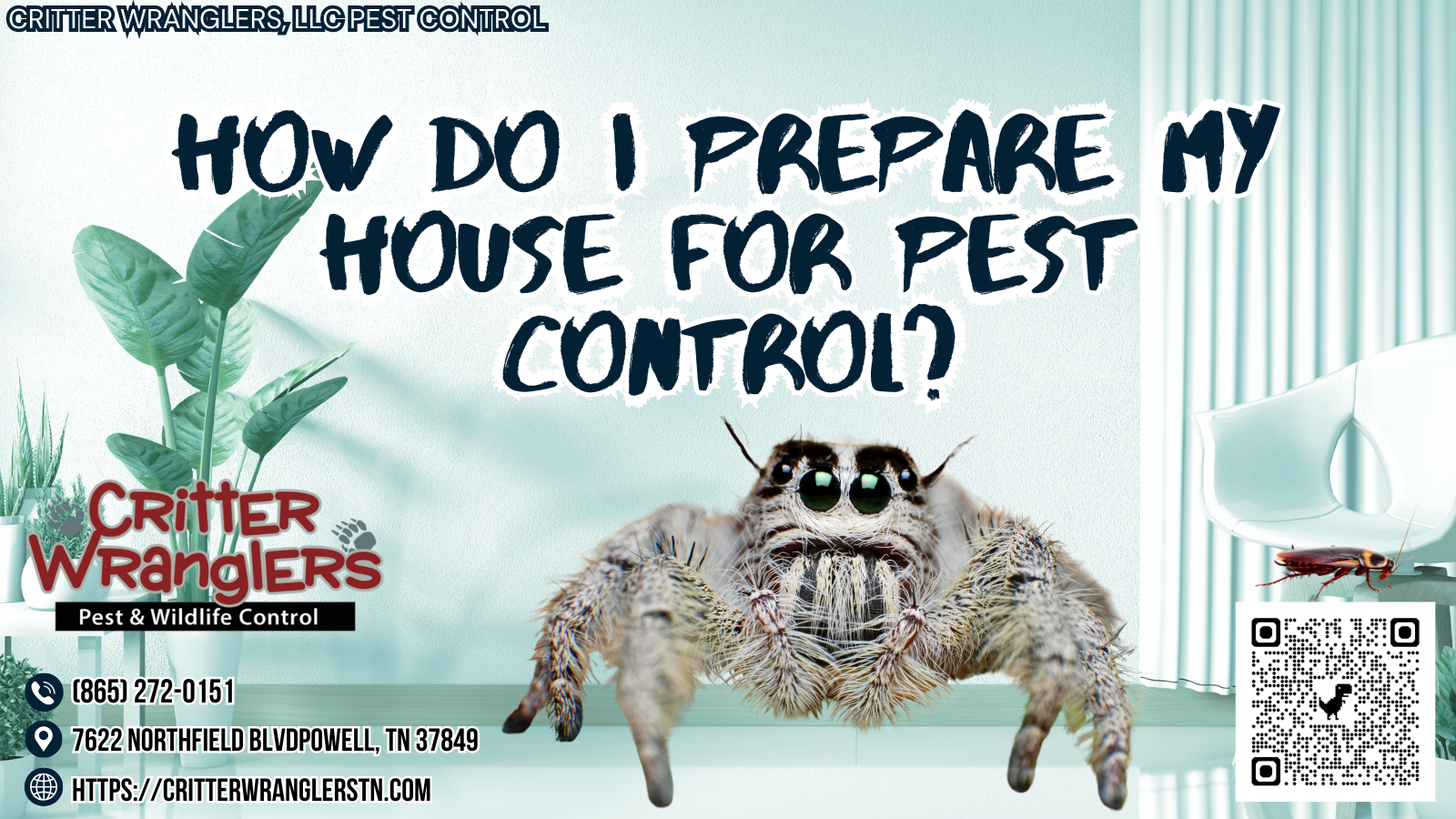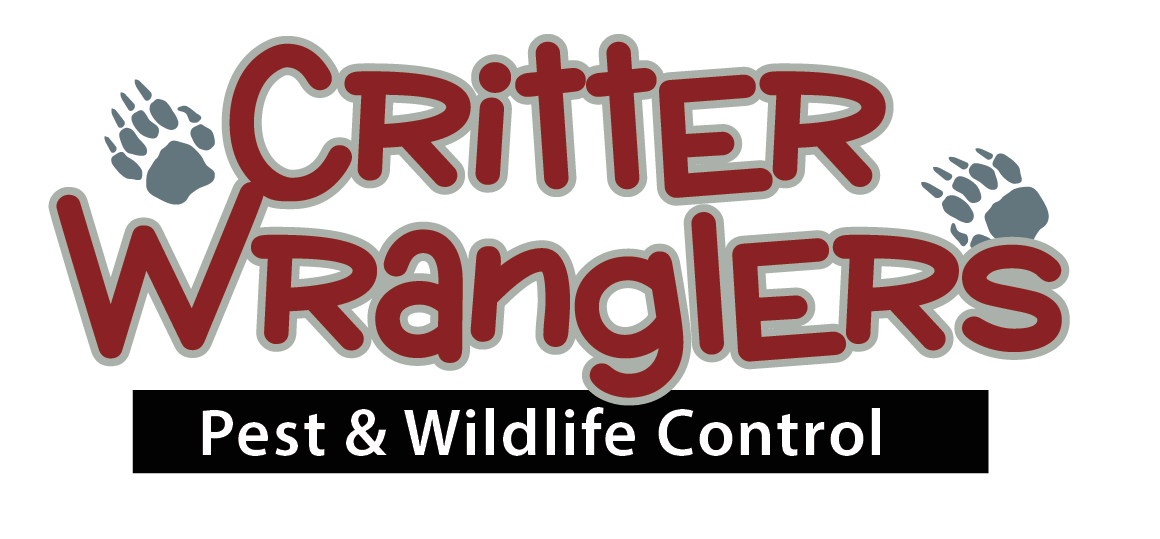Critter Wranglers, LLC Blog
Have an issue? Contact us today

How Do I Prepare My House for Pest Control?
To prepare your house for pest control, start by decluttering your living spaces. This includes removing items that obstruct access to treatment areas. Thoroughly clean all surfaces to eliminate food particles that attract pests. Secure food and pet supplies in airtight containers. Inspect and seal any entry points, such as cracks and gaps in windows and doors. Move furniture away from walls for easier access. It’s also crucial to inform your pest control technicians about any specific concerns. With these steps, you’ll guarantee a more effective pest control treatment and a healthier home environment. More insights are available on this topic.
Key Article Highlights
- Declutter your living space by removing boxes, furniture, and obstacles to enhance pest control efficiency and technician access.
- Clean all surfaces thoroughly, especially in kitchens and dining areas, to eliminate food particles that attract pests.
- Secure food and pet supplies in airtight containers, and organize your pantry to prevent pest access and spills.
- Inspect and seal potential entry points, including windows and cracks, using caulk or weather stripping to reduce pest access.
- Communicate with pest control technicians about specific pest concerns and ensure they have access to all areas of your home.
Declutter Your Living Space
One of the most effective ways to prepare for pest control is to declutter your living space. A clean and organized environment allows pest control professionals to access all areas of your home. Start by organizing belongings, placing items in designated areas, and removing unnecessary clutter. This not only helps the technicians but also minimizes distractions during their work. Focus on high-traffic areas, such as kitchens and living rooms, where pests are often found. Clear out any boxes, bags, or furniture that may hinder treatment. By decluttering, you create a more effective pest control environment. This proactive approach can enhance the results of the treatment, ensuring your home is pest-free and comfortable.
Clean All Surfaces
Thoroughly cleaning all surfaces in your home is essential before pest control treatment. This step helps remove food particles and residues that may attract pests. Focus on various surface types, including countertops, tables, and floors. Use effective cleaning products to guarantee a thorough clean.
| Surface Type | Recommended Cleaning Product | Cleaning Technique |
|---|---|---|
| Kitchen Counter | All-purpose cleaner | Wipe down with a cloth |
| Wooden Table | Mild soap solution | Use a damp cloth |
| Tile Floor | Floor cleaner | Mop thoroughly |
Secure Food and Pet Supplies
To prepare for pest control, it is important to secure food and pet supplies. Store all food in airtight containers to prevent pests from accessing it. Additionally, seal pet supplies in similar containers to keep them safe and discourage infestations.
Store Food Properly
Proper food storage is essential in preventing pest infestations during pest control preparations. Begin by organizing your pantry effectively. Guarantee all food items are sealed tightly in airtight containers. This includes grains, cereals, and snacks, which can attract pests. Check for any expired products and dispose of them properly. Additionally, store pet food in secure containers, as pests can be drawn to these supplies as well. Keep your pantry clean and free of crumbs or spills, as these can also attract unwanted guests. By prioritizing food storage and maintaining pantry organization, you reduce the risk of pests entering your home during treatment. Taking these steps will help create a safer environment for both your family and pest control professionals.
Seal Pet Supplies
Guaranteeing that pet supplies are securely sealed is crucial in preventing pest infestations during pest control preparations. Proper pet food storage plays a key role in this process. Open bags of pet food can attract unwanted pests, so it is important to transfer them into pest proof containers. These containers are designed to keep pests out while preserving the freshness of the food. Choose containers that are airtight and made from durable materials to guarantee maximum protection. Additionally, store treats, medications, and toys in similar pest proof containers. By taking these steps, you can create a barrier that protects your pet supplies and minimizes the risk of pests entering your home during the pest control process.
Remove Clutter From Floors
When preparing for pest control, one essential step is to remove clutter from floors. Excess items on the floor can create hiding spots for pests, making treatment less effective. Start by organizing storage in your home, placing items in bins or on shelves. This not only reduces clutter but also makes it easier for pest control professionals to access all areas of your home. Make certain that pathways are clear, allowing technicians to move freely without obstacles. This approach enhances their ability to inspect and treat your space thoroughly. By taking these steps, you contribute greatly to the effectiveness of the pest control process, making sure that your home is well-prepared for treatment and minimizing the chance of future infestations.
Inspect and Seal Entry Points
After clearing the floor of clutter, the next important step is to inspect and seal entry points around your home. Conduct a thorough entry point evaluation to identify potential access areas for pests. Check windows, doors, vents, and any cracks in the foundation. Pay special attention to gaps and holes, as these can easily allow pests to enter. Once you identify these vulnerabilities, employ appropriate sealing techniques. Use caulk for small cracks and weather stripping for doors and windows. For larger openings, consider expandable foam or metal mesh. By effectively sealing these entry points, you can considerably reduce the likelihood of pests entering your home, thereby enhancing the effectiveness of pest control treatments.
Move Furniture Away From Walls
To facilitate effective pest control, moving furniture away from walls is an essential step. Proper furniture placement helps create a clear path for pest control technicians. When furniture is against walls, it can obstruct access to wall gaps where pests often hide. These gaps are common entry points for insects and rodents. By moving furniture, you allow for a thorough inspection and treatment of these areas. It is advisable to relocate items at least a few inches away from walls. This not only aids in pest control but also allows for better airflow and cleaning. Taking these steps guarantees that pest control measures are both effective and all-encompassing, helping to maintain a pest-free environment in your home.
Inform Pest Control Technicians
How can you guarantee that pest control treatments are as effective as possible? One vital step is to inform pest control technicians about your specific concerns. Clearly communicate any pest issues you have noticed, such as the type of pests or the areas where they are most active. This information helps technicians tailor their approach effectively.
Additionally, it is important to provide access to all areas of your home. Ascertain that technicians can reach basements, attics, and crawl spaces, as these are common hiding places for pests. By facilitating this access, you allow technicians to conduct a thorough inspection and treatment. Taking these steps will enhance the overall effectiveness of the pest control process, leading to a healthier and pest-free environment.
Plan for Temporary Relocation
When planning for pest control, you may need to take into account temporary relocation. Assess your housing options, whether it’s staying with friends, family, or finding a short-term rental. Additionally, inform your neighbors and friends about the situation to make certain they are aware of the temporary change.
Assess Temporary Housing Options
Where will you stay during pest control treatments? Evaluating temporary housing options is essential for a smooth experience. Begin by considering local hotels or motels that offer temporary accommodations. Check for cleanliness and pest control practices at these locations to guarantee a safe environment. Alternatively, consider staying with family or friends if feasible. This option can provide comfort and familiarity during the treatment period. If your home requires extensive treatment, you may explore short-term rental services, which often provide a home-like atmosphere. Regardless of your choice, plan to secure your temporary housing well in advance. This preparation will minimize stress and ensure you have a comfortable place while your home is being treated for pests.
Notify Neighbors and Friends
Notifying neighbors and friends about your pest control plans is an important step to contemplate, as it fosters understanding and cooperation during this process. Effective neighbor communication can ease any concerns they may have about the treatments. It is also wise to inform friends who may visit your home during this time. Their support can provide comfort and assistance.
| Action | Purpose | Timing |
|---|---|---|
| Inform neighbors | Prevent misunderstandings | One week prior |
| Notify friends | guarantee support during relocation | One week prior |
| Discuss concerns | Address any issues or fears | One week prior |
| Confirm arrangements | Secure temporary accommodations | Three days prior |
| Follow up | Maintain relationships | After treatment |
Clear communication leads to a smoother pest control experience.
Frequently Asked Questions
How Long Should I Stay Out of My House After Treatment?
After pest control treatment, it is generally recommended to stay out of your house for at least 2 to 4 hours. This duration guarantees treatment safety and allows chemicals to settle effectively, minimizing exposure risks.
Can I Schedule Pest Control During a Rainy Season?
Scheduling pest control during a rainy season can be a delicate dance. Weather considerations are essential, as moisture may affect treatment efficacy. Ideal pest control timing often favors dry conditions for best results and lasting impact.
What Types of Pesticides Will Be Used?
The types of pesticides used depend on the specific pest problem. It is crucial to guarantee chemical safety during pesticide application, as various formulations target different pests while minimizing risks to humans and the environment.
Are There Any Risks to My Pets During Treatment?
Approximately 70% of pet owners express concern over pesticide exposure. To guarantee pet safety, it is essential to follow treatment precautions, such as keeping pets away during application and allowing adequate ventilation afterward.
How Often Should I Schedule Pest Control Services?
Frequency recommendations for pest control services typically suggest treatments every three months. However, seasonal considerations, such as increased pest activity during warmer months, may necessitate more frequent visits to effectively manage infestations and maintain a pest-free environment.
